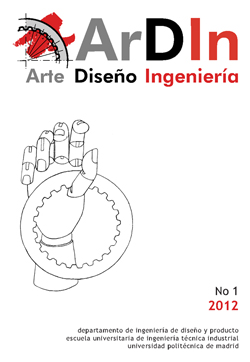Arte, Diseño e Ingeniería: tres fuentes de la creación = Art, Design and engineering: three sources of creation
Keywords:
Arte e ingeniería, diseño e ingeniería, diseño y arte, Art and engineering, Design and engineering, Design and art.Abstract
Resumen
Este trabajo es de acercamiento y por tanto no pretende responder al modelo de ensayo o tesis; arranca sin hipótesis previa y expresa; discurre por una serie no exhaustiva de temas relacionados con las tres disciplinas de la revista, en busca de áreas de interés sobre las que en trabajos posteriores tengan cabida ensayos de mayor profundidad. Algunos son más evidentes, como es el caso de diseño e ingeniería, o artefactos y mejora de la vida cotidiana; otros están menos relacionados tradicionalmente con el avance técnico, como la capacidad del Arte de prefigurar escenarios. Teoría como valor añadido, la evolución de la actividad del diseño, el valor de la mentalidad del ingeniero, su papel y responsabilidad moral, la conveniencia de la independencia de crítica y práctica, y la importancia de los resultados, conforman el abanico central de temas que entendemos importantes a tener en cuenta en el debate. La tercera parte toca herramientas metodológicas como creatividad y automanejo, autoconfianza, y abandono del problema equivocado con el modelo de los cuatro marcos, concluyendo con unas máximas de utilidad para el desarrollo de la carrera profesional.
Abstract
This approach is not intended to respond to an essay or thesis model, so it starts without an express prior hypothesis, and runs a non-exhaustive set of issues related to the three disciplines of the magazine, looking for areas of interest that could have a place later works. Some are more obvious, as it happens to design and engineering, or artifacts and improving everyday life; others are less traditionally associated with technical advances such as the ability to prefigure Art scenarios. The value of Theory and the evolution of design activity, the value of the mindset of the engineer, his role and moral responsibility, the independence of critical and practical, and the importance of the results, form the core range of topics we understand important to consider in the debate. The third part touches methodological tools such as creativity and self-management, self-confidence, and leaving the wrong problem with the model of the four frames, concluding with three useful ideas for career development.
Downloads
Downloads
Published
Issue
Section
License
ArDIn does not charge authors for processing or publishing an article and provides immediate Open Access to its content. All content is available free to the user or their institution. Users are permitted to read, download, copy, distribute, print, search or link to the full text of articles, or use them for any other lawful purpose, without prior permission from the publisher or author. This is in accordance with the BOAI definition of open access.
- Authors retain the copyright and grant to the journal the right to a Creative Commons attribution / Non-Commercial / Non-Derivative 4.0 International (CC BY NC ND) License that allows others to share the work with an acknowledgement of authorship and non-commercial use.
- Authors may separately establish additional agreements for the non-exclusive distribution of the version of the work published in the journal (for example, placing it in an institutional repository or publishing it in a book).
Unless otherwise indicated, all contents of the electronic edition are distributed under a Creative Commons license.













